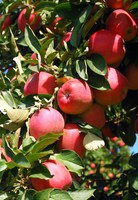Prairie Fare: Be Inspired by Apples
(Click the image below to view a high-resolution image that can be downloaded)
By Julie Garden-Robinson, Food and Nutrition Specialist
NDSU Extension Service
As I stood at the kitchen sink, I looked out the window and admired the abundant bright red apples near the top of our backyard tree. Unfortunately, the apples were too high for us to reach. As I pondered how we would harvest the apples, I heard screams coming from the living room.
“Oh no! Oh no! Don’t do it!” my daughters squealed in unison.
I ran to the living room to where my daughters were looking out the window. When I saw what they were viewing, I joined the chaos.
Our three dachshunds were in hunting mode positioned at the base of our apple tree, looking up at two chattering squirrels at the top of the apple tree. One of the squirrels was ready to leap from the apple tree to a pine tree. If it missed the mark, we knew its fate.
My daughters were trying to warn the trapeze-artist wannabes not to mess with our dachshund gang of three.
I had been wondering how some of the apples were landing on the ground. I think the squirrels have been bombing our dogs with these juicy relatives of the rose.
Fortunately, the acrobatic rodents landed in the foliage and scampered away. If only I could train the squirrels to juggle and toss me the apples, I thought to myself. I guess a tall ladder and an apple picker will have to suffice.
We all could benefit from gathering some apples and eating them. Apples have long been a symbol of good nutrition because they provide fiber and natural antioxidants. A large apple has about 130 calories and 5 grams of fiber.
University of California-Davis researchers have reported that eating two apples or drinking 12 ounces of apple juice per day protected arteries by preventing the buildup of plaque.
Apples provide insoluble fiber (“roughage”) to promote digestive health, as well as soluble fiber (pectin) that has been shown to help lower blood cholesterol levels. Whenever possible, eat the skin as well as the flesh.
More than 7,500 apple varieties are grown throughout the world, and 2,500 varieties are grown in the U.S. On average, we eat about 46 pounds of apples and processed apple products every year.
Apples have different “best” uses. Some apples are tart, others are crunchy and some withstand heating without becoming mushy. Some varieties, such as the Haralson apples in my backyard, are “all-purpose” so they can be used for baking, salads, pies and sauce. For example, Granny Smith, Braeburn, Jonagold and Golden Delicious apples usually are categorized as all-purpose.
If you have a bumper crop of apples from your own backyard, you can preserve them in many ways. If you make apple juice or cider, be sure to pasteurize it by heating it to 160 degrees to kill disease-causing bacteria that may have hitched a ride on the fruit.
Try freezing high-quality apples with these easy directions. To prevent darkening of apples during preparation, dissolve 1/2 teaspoon of ascorbic acid (available in the canning supplies area) in 3 tablespoons of water. Sprinkle over the fruit. To retard darkening, place slices in a single layer in a steamer; steam 1 1/2 to 2 minutes, depending on the thickness of the slices. Cool in cold water; drain. Over each quart (1 1/4 pounds) of apple slices, sprinkle evenly 1/2 cup sugar and stir. Pack apples into containers and press fruit down. Leave head space, then seal and freeze. To make an unsweetened pack, simply omit the sugar.
More information about freezing various fruits is available at http://www.ag.ndsu.edu/pubs/yf/foods/fn182frzfts.pdf.
To learn about preserving fruit through dehydration, see “Drying Fruits” at http://www.ag.ndsu.edu/pubs/yf/foods/fn1587.pdf.
To learn about canning various fruits, see “Home Canning Fruit and Fruit Products” available at http://www.ag.ndsu.edu/pubs/yf/foods/fn174.pdf.
Here is a tasty recipe courtesy of University of Illinois Extension.
Apple Cranberry Crisp
1/2 c. all-purpose flour
1/2 c. old-fashioned oatmeal
1/2 c. each, granulated sugar and brown sugar
1/2 tsp. cinnamon
1/2 tsp. nutmeg
1/2 stick (1/4 cup) chilled butter or margarine cut into small pieces
7 c. peeled diced apples (about 3 pounds)
3 Tbsp. apple juice or cider
1/2 c. dried cranberries
Preheat oven to 375 F. Lightly coat 8-inch baking dish with cooking spray or oil and set aside. In a bowl, combine flour, oatmeal, brown sugar, granulated sugar, cinnamon and nutmeg until well blended. Cut in chilled butter using a pastry blender or clean fingers until the mixture is crumbly. In another bowl, combine apples, apple juice and cranberries. Spoon the apple mixture into prepared pan. Sprinkle with crumb mixture. Cover with foil and bake for 30 minutes. Uncover and bake an additional 20 minutes or until golden brown. Serve warm topped with vanilla ice cream or whipped cream.
Makes nine servings. Each serving has 260 calories, 6 grams (g) of fat, 55 g of carbohydrate, 3 g of fiber and 50 milligrams of sodium.
(Julie Garden-Robinson, Ph.D., R.D., L.R.D., is a North Dakota State University Extension Service food and nutrition specialist and professor in the Department of Health, Nutrition and Exercise Sciences.)
NDSU Agriculture Communication – Oct. 10, 2013
| Source: | Julie Garden-Robinson, (701) 231-7187, julie.garden-robinson@ndsu.edu |
|---|---|
| Editor: | Rich Mattern, (701) 231-6136, richard.mattern@ndsu.edu |


